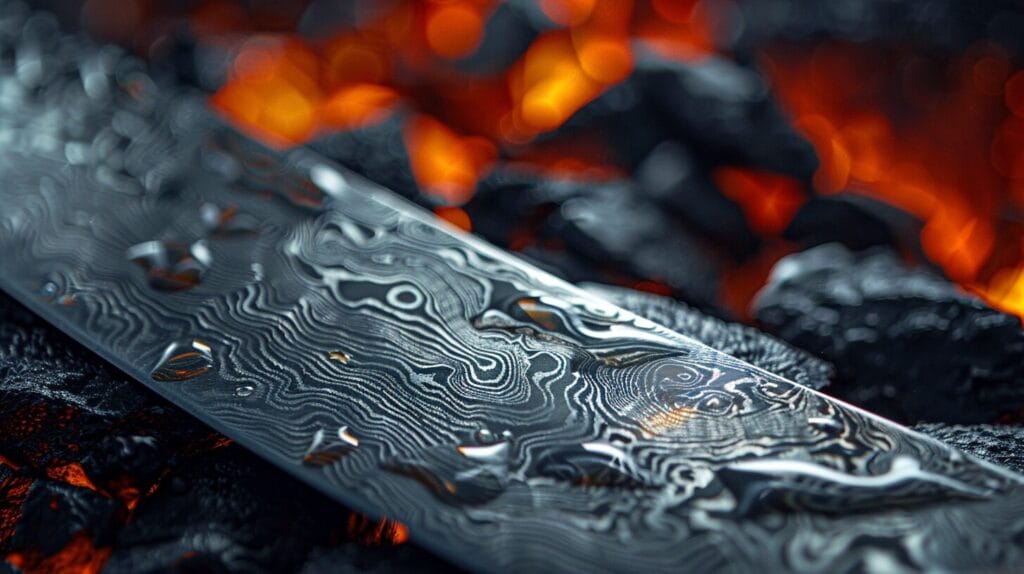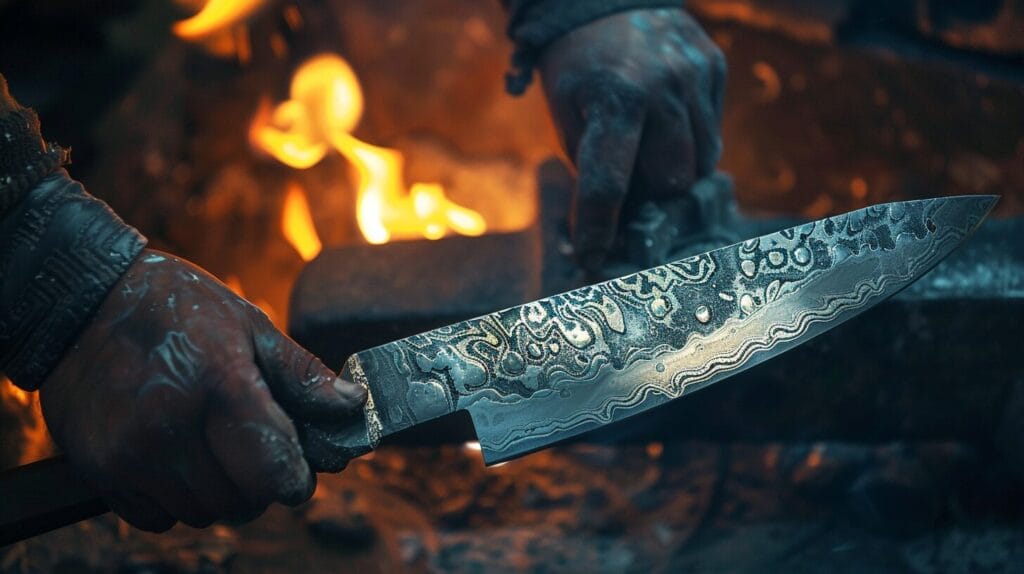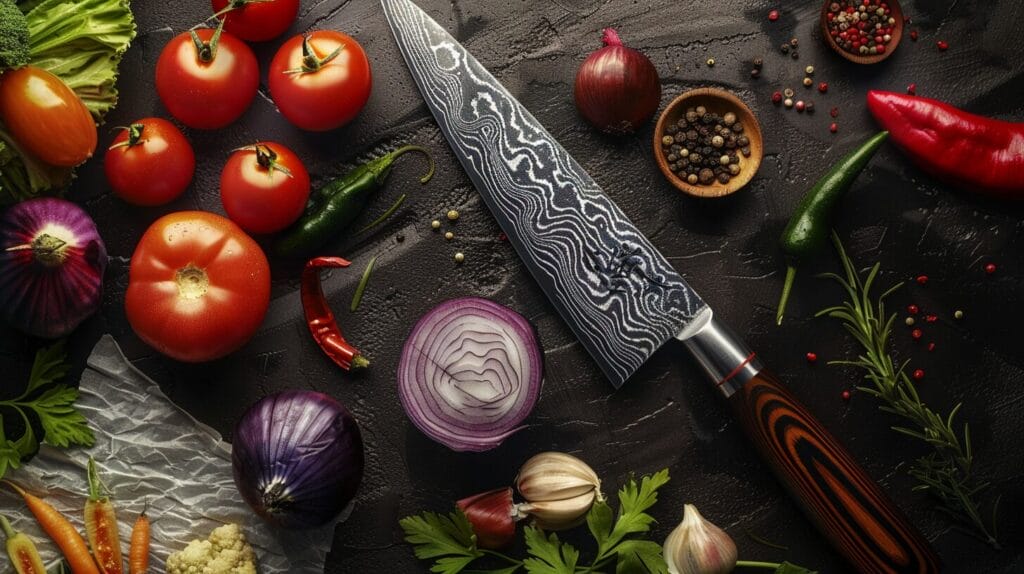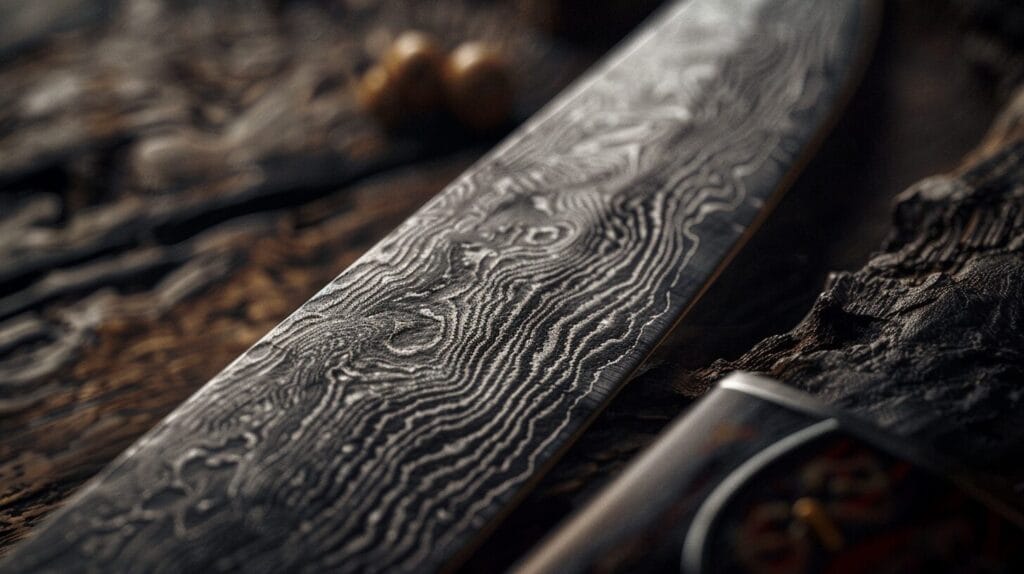When you encounter a Damascus knife in a high-end kitchen, its standout feature is the distinctive wavy pattern that catches your eye. However, there’s more to these knives than just their striking appearance. The unique construction of a Damascus knife offers advantages in terms of strength and sharpness.
As you contemplate whether a Damascus knife is a worthwhile addition to your culinary tools, you’ll discover the intricacies of their manufacturing process, their versatility for different tasks, and whether their higher cost truly corresponds to superior performance. Exploring what distinguishes these knives may lead you to question if your kitchen is missing out on something extraordinary.
Key Takeaways
A Damascus knife is a special blade that combines beauty and strength by intricately folding and merging layers of steel. When you hold one, you’re not just holding a tool but a piece of history that is sharper, more durable, and uniquely patterned.
These knives are exceptional at cutting through tough materials and performing delicate cuts, setting them apart from other knives. The price of a Damascus knife reflects its craftsmanship and high performance, proving its worth.
Embrace the Damascus knife; it’s more than just a knife—it’s a legacy in your hands.

What makes a Damascus knife special?
Damascus knives stand out due to their captivating patterns, which reflect a time-honored forging technique.
Their rich history adds to their appeal as more than just cutting tools.
Today, these knives are valued not only for their beauty but also for their practicality in kitchens and collections worldwide.
Damascus knife pattern
The Damascus knife pattern is a true art form crafted from ancient forging techniques. It showcases a blend of different types of Damascus steel, creating unique and intricate designs on each blade.
The mixture of high-carbon and low-carbon steel contributes to the distinct patterns, while the process of welding, folding, and hammering the steel multiple times results in the swirling designs characteristic of Damascus knives.
Each Damascus knife is a one-of-a-kind masterpiece due to the varied techniques and types of Damascus steel used in its creation.
History of Damascus steel
Unveiling the origins of Damascus steel sheds light on why these knives transcend mere functionality to become symbols of ancient craftsmanship and creativity. With a heritage spanning more than 2,000 years, this extraordinary material first emerged in India and Persia before making its way to Damascus, Syria.
Here, the city became renowned for producing the finest swords and blades of the ancient world, renowned for their exquisite appearance and unparalleled strength, flexibility, and enduring sharpness. The distinction of Damascus knives lies in this legacy of excellence, connecting them to a bygone era of exceptional craftsmanship and advanced metallurgical techniques.
Process of forging Damascus knives
In the contemporary process of crafting Damascus knives, blacksmiths employ a technique known as pattern welding to replicate the distinctive look of traditional Damascus steel.
- Layering: Initially, layers of iron and steel are stacked and forge-welded together.
- Folding: The amalgamated metals undergo heating, hammering, and repeated folding, resulting in the creation of intricate patterns.
- Etching: To highlight the contrasting layers and designs, the blade is subjected to acid etching, ultimately transforming each Damascus knife into a one-of-a-kind piece of art.
Damascus knives today
When we look at Damascus knives in today’s world, we see not just their historical importance but also their exceptional craftsmanship and durability. These knives are more than just tools; they’re pieces of art, each with a unique aesthetic that makes them stand out.
The secret to their outstanding qualities lies in the layered steel used in their construction. This special design not only catches the eye but also creates a blade that’s both strong and flexible. As a result, Damascus knives can maintain a sharp edge for a much longer time compared to many other knives available.

Are Damascus knives stronger or sharper than other knives?
When comparing Damascus knives to others, their strength and sharpness depend more on the specific alloys used than on the Damascus pattern itself. While the aesthetic of Damascus steel is striking, the quality of the material ultimately determines the knife’s performance.
Here’s what you need to know about the strength and sharpness of Damascus knives:
- Quality Over Pattern: Damascus steel knives aren’t inherently stronger or sharper than other high-quality knives. The performance largely depends on the steel alloys incorporated. A well-crafted Damascus knife made from superior steel can be exceptional, but so can a knife of a single, high-quality alloy.
- Historical vs. Modern: The original Damascus steel, known as wootz, was celebrated for its durability and edge retention. Modern Damascus knives, while visually reminiscent of this legendary metal, are prized more for their looks. The actual strength and sharpness depend on the manufacturing process and the materials used.
- Reputable Manufacturers: It’s important to buy from reputable sources. They’ll specify the types of steel used, ensuring you get a knife that’s not only beautiful but also performs well. Cheaper, mass-produced versions may not hold up in terms of quality and performance.

How are Damascus knives made?
Damascus knives are crafted by stacking alternating layers of high-carbon and low-carbon steel, heating them in a forge up to 2,300°F, and then hammering and folding the metals to form a solid billet.
The craftsman manipulates the layers to create intricate patterns like twists, ladders, or raindrops. This meticulous process includes normalizing the billet to relieve stresses, annealing it for durability, and using 1084 and 15N20 steels for hardening and tempering the blade.
The final etching in acid reveals the stunning patterns and ensures exceptional strength and flexibility in the finished blade. This intensive yet rewarding process sets Damascus knives apart with their unique beauty and functionality.

Are Damascus knives good for all uses?
Damascus knives, celebrated for their precision and elegance, may not always be the ideal choice for every cutting task you encounter in the kitchen. While they excel at slicing through meat, fish, and vegetables with exceptional ease, their design has certain limitations you should be aware of. Let’s explore their strengths and weaknesses in more detail:
- Precision Cutting Tasks: Damascus knives shine when it comes to fine slicing and dicing. Their razor-sharp edges and flexibility make them perfect for achieving precise cuts that are hard to replicate with other types of knives.
- Heavy-Duty Chopping: If you need to cut through bones or other tough materials, Damascus knives may not be the most suitable option. Their thin and flexible blades can be vulnerable to chipping or bending under such demanding use.
- Everyday Kitchen Tasks: Due to their higher cost and specialized capabilities, using a Damascus knife for everyday kitchen chores mightn’t be the most practical choice. Opting for a more durable and cost-effective knife could be a better fit for routine tasks.

How much more expensive are Damascus knives?
Damascus knives are typically more expensive than regular knives because of their complex production process, the high demand for their exceptional quality, and the use of premium materials.
The reputation of the brand also contributes to their higher price tag. Understanding these factors can help you determine if investing in a Damascus knife aligns with your needs and budget.
The production
When considering the cost disparity, it’s crucial to assess whether a Damascus knife is a worthwhile investment. The creation of a Damascus knife transcends mere production—it embodies an art form that necessitates exceptional expertise and a considerable amount of time. Here’s why they may come with a higher price tag:
- Craftsmanship: Crafting a Damascus knife demands the mastery of a skilled bladesmith, a rare and specialized profession.
- Time-Consuming Process: The meticulous construction of a single Damascus knife can span over 200 hours, involving the repetitive folding and welding of steel to achieve its distinctive pattern.
- Materials: The use of top-notch materials is imperative to endure the demanding process of crafting Damascus steel, contributing significantly to the overall cost.
The intricate blend of skill, time, and materials justifies the elevated cost of Damascus knives in comparison to their conventional counterparts.
High demand
High demand contributes significantly to the cost of Damascus knives. The scarcity of authentic Damascus steel, its rich history, and the complex production process all play a role in driving up prices.
Collectors and knife enthusiasts drive the demand for these knives, resulting in a considerable price difference compared to ordinary knives. The cost varies depending on factors such as design, maker, and quality.
When considering whether to invest in a Damascus knife, it’s essential to balance the price with the unique value and aesthetic appeal these knives offer.
Quality materials
Considering the Cost of Damascus Knives
When looking at a Damascus knife, it’s important to understand that the use of top-notch materials significantly raises their price compared to regular knives. These materials not only enhance the knife’s appearance but also its strength and performance. Here’s how:
- High-Quality Steels: The multiple layers of steel in a Damascus knife require top-quality materials that can endure the forging process, increasing the cost.
- Customization Options: The array of choices in handle materials and designs are vast, allowing for personal touches that elevate the knife’s worth and cost.
- Craftsmanship: The complex art of crafting a Damascus blade involves a level of skill that commands a higher price tag.
Brand reputation
Is Brand Reputation Important for Damascus Knife Prices?
When considering the cost variations of Damascus knives due to materials and craftsmanship, it’s essential to also analyze the impact of a brand’s reputation on pricing. Knives made by well-known master bladesmiths or prestigious brands can come with a high price tag, sometimes exceeding $1,000.
This is because the reputation of a brand for top-notch quality and exceptional craftsmanship significantly influences the value of the knife. When deciding if investing in a Damascus knife is worthwhile, remember that you’re not only purchasing the knife itself but also the legacy, expertise, and prestige associated with its manufacturer.
While this can lead to a significant price difference, many find that the promise of superiority and a reputable brand history justifies the additional cost.
Frequently Asked Questions
Can Damascus Knives Rust or Corrode Over Time, and How Should They Be Maintained to Prevent This?
Damascus Knives can rust or corrode if not properly cared for. To prevent this, you should regularly oil and clean them, and make sure they’re completely dry before storing them away.
Are There Any Specific Foods or Materials That Should Not Be Cut With a Damascus Knife to Preserve Its Edge and Finish?
In order to preserve the edge and finish of your Damascus knife, it is advisable to avoid cutting hard materials such as bones or frozen foods. Stick to softer foods to maintain the blade’s sharpness and overall quality.
How Can You Authenticate a Real Damascus Knife and Distinguish It From a Fake or Lower-Quality Imitation?
To authenticate a genuine Damascus knife, it is essential to closely inspect the intricate patterns present in the blade. Genuine Damascus knives exhibit patterns that run all the way through the edge of the blade, rather than just being superficial. Additionally, it is advisable to look for a distinguished maker’s mark which serves as a hallmark of quality and authenticity.
What Is the Historical Significance of the Patterns Seen on Damascus Blades, and Do They Have Any Cultural Meanings?
The historical significance of the patterns on Damascus blades lies in their representation of strength, purity, and the artistry of ancient blacksmiths. These designs carry centuries of cultural meaning, reflecting the skills and traditions passed down through generations.
How Does the Weight and Balance of a Damascus Knife Compare to That of Other High-End Kitchen Knives?
The weight and balance of a Damascus knife are often lighter and more balanced than other high-end kitchen knives, which can make it easier for precise cuts and reduce hand fatigue during extended use.
Conclusion
Damascus knives tell a story of beauty and strength through the intricate dance of steel layers folding and merging. When you hold one, you’re not just possessing a tool but a piece of history that’s sharper, more resilient, and uniquely patterned.
These knives excel at slicing through tough materials and executing delicate cuts, setting them apart from the rest. The price tag reflects their craftsmanship and performance, proving their value.
Embrace the Damascus knife; it’s not just a knife—it’s a legacy in your hands.

